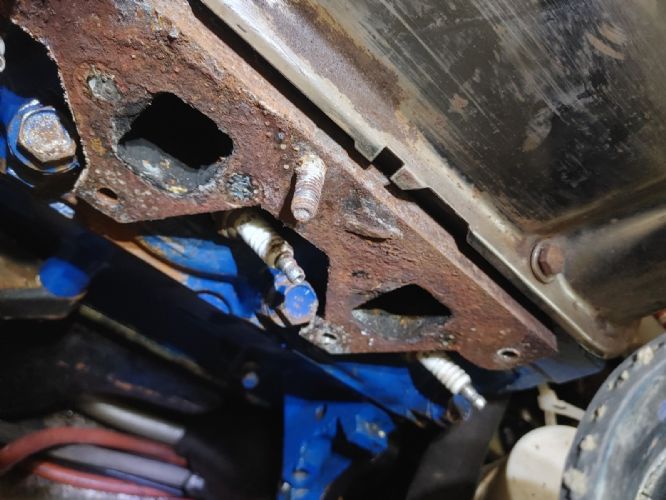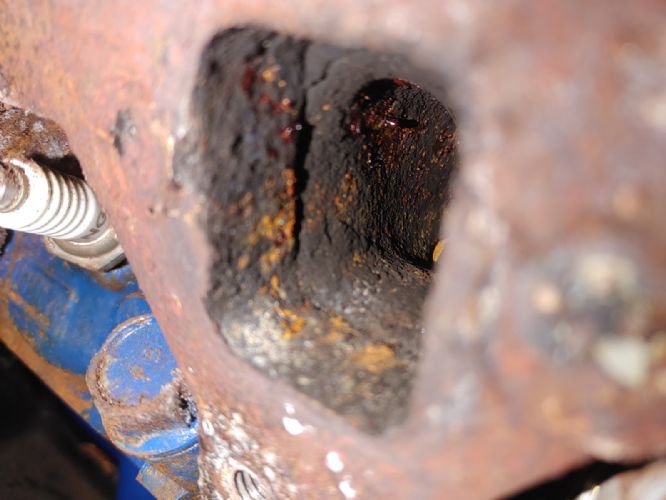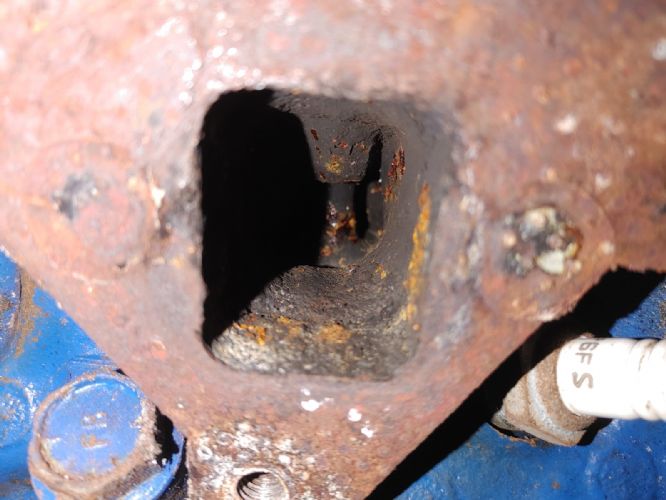Exhaust manifolds, ports and valves
Printed From: CorrectCraftFan.com
Category: Repairs and Maintenance
Forum Name: Boat Maintenance
Forum Discription: Discuss maintenance of your Correct Craft
URL: http://www.CorrectCraftFan.com/forum/forum_posts.asp?TID=50837
Printed Date: April-26-2025 at 2:29am
Topic: Exhaust manifolds, ports and valves
Posted By: Wilhelm Hertzog
Subject: Exhaust manifolds, ports and valves
Date Posted: August-13-2022 at 9:10am
|
I have a bit of a https://www.correctcraftfan.com/forum/forum_posts.asp?TID=47357&KW=new+zealand&PID=584947&title=pcm-351w-fresh-water-cooling-fwc#584947" rel="nofollow - Frankenstein exhaust system on my boat. Because there has been a small but persistent exhaust leak at the no. 4 cylinder port, and because the port side exhaust gasket had, for some reason, disintegrated (see picture below), I decided to pull the exhausts and clean/fix things up while it is winter here in the southern hemisphere. Judging by the look of the port side manifold adapter plate (necessary to make the Chevy manifold fit the Ford heads) and the gasket, my best guess is that there has been quite a bit of water intrusion between the gasket and the adapter plate over time. I never noticed any water leaks around that area, but I can't imagine the amount of corrosion there could have come about in any other way. Looking inside the exhaust ports (specifically on cylinder no.8) also revealed what to me looks like signs of water intrusion - refer to the pictures. Spark plug no.8 was also noticeably wetter than most of the other spark plugs when I pulled them. My prime suspect for a water leak is the port side riser gasket. I did once pull the riser off and damaged the gasket slightly, but bolted the riser back on without replacing the gasket. There were never external leaks, but obviously there may have been leaks into the exhaust passages and ports. So, if anyone can give me some guidance on the following it will be hugely appreciated: 1. What is the best way to clean up the dirt/corrosion around the exhaust valve (without pulling the heads)? Scrub with a small soft brush with the valve in its closed position, and a vacuum at the exhaust port outlet? I imagine one wants to stay away from that area with a wire brush, lest a wire bristle detaches from the brush and ends up dropping into the cylinder. 2. I am not entirely sure what metal the adapter plate is made of, but it is magnetic, and it is clearly not stainless steel or aluminium, so my best guess is cast iron. The exhaust manifolds and risers are aluminium, which may create the potential for galvanic corrosion? My suspicion is that galvanic corrosion is what ate up the gasket - and has caused some pitting of the exhaust manifold flanges (see last picture), as there was a good amount of white powder in that area, which I suspect to be oxidised aluminium. What will be the best gasket material to use between the adapter plate and the exhaust manifold? I have to have custom gaskets cut in any event, so I am not limited to (or don't have the option of) using OEM gaskets and gasket material. Yes, I can convert everything back to stock and have fewer of these issues to deal with, but given shipping costs and import duties new exhaust manifolds and risers cost an arm and a leg in South Africa, and the ones I have are in good shape - other than the exhaust flanges (which are slightly warped, hence the small leaks), which I'm getting fixed by an engineering shop. Thanks for any help and pointers! Remains of port side exhaust gasket:  Port side exhaust adapter plate and exhaust ports:  Close up of cylinder 7 and 8 exhaust ports:  Cylinder 8 exhaust port inside:  Cylinder 8 exhaust valve:  For comparison, starboard adapter plate and exhaust ports (generally in better shape than port side, though I have cleaned it up a bit, which I haven't really for the port side):  Risers and manifolds:  ------------- 1982 Ski Nautique PCM351W RR II Velvet Drive 10-17-003 1:1 II PerfectPass Stargazer Do not go gentle into that good night. Rage, rage against the dying of the light. |
Replies:
Posted By: Wilhelm Hertzog
Date Posted: August-15-2022 at 5:45pm
|
Anyone? ------------- 1982 Ski Nautique PCM351W RR II Velvet Drive 10-17-003 1:1 II PerfectPass Stargazer Do not go gentle into that good night. Rage, rage against the dying of the light. |
Posted By: KENO
Date Posted: August-16-2022 at 7:35am
Someone  There shouldn't be any water at the joints between your head, adapter and manifold. There's only exhaust gases passing through that area, unless you have a water leak from the water jacket of the manifold to the exhaust gas side or an leak into the cylinder(s) from a head gasket leak for example. Gasket material............. people use aluminum heads and steel, cast iron exhaust on engines without any issues (just the opposite of your situation) with no galvanic corrosion issues especially since they're not submerged in water. I think you maybe had worn out gaskets because the adapters weren't flat and exhaust leaks ate away the material. Shouldn't a Chevy 5.3 exhaust gasket fit on the manifold side and a Ford 351w gasket fit on the other side of the adapter plate and not give you the need for anything custom cut? Or is the custom cutting cheaper than getting gaskets imported. Your carbon scraping plan sounds reasonable with the valve closed and a vacuum cleaner to clean things out. Probably not much else you can do
|
Posted By: Wilhelm Hertzog
Date Posted: August-16-2022 at 5:17pm
|
Just the someone I was looking for - thanks Ken ;-). I was thinking exactly what you're thinking about the gaskets, but for some reason the hole pattern in the manifolds don't match the standard Chevy gaskets. But no big deal - as long as I know the standard gasket material won't cause issues between the aluminium and cast iron I can deal with the rest. ------------- 1982 Ski Nautique PCM351W RR II Velvet Drive 10-17-003 1:1 II PerfectPass Stargazer Do not go gentle into that good night. Rage, rage against the dying of the light. |
Posted By: FrankBee3
Date Posted: January-29-2023 at 4:18pm
|
I don't understand the need for adapter plates? It looks like the exhaust manifolds are for an engine that is not the Ford/PCM 351W? Wouldn't it be better to have exhaust manifolds and risers for the PCM Ford? There would be no need for an adapter plate. Something like this. https://skidim.com/manifold-exhaust-302-351.html ------------- 1984 Ski Nautique, project bigger than anticipated Staring down a stringer and floor replacement |
Posted By: KENO
Date Posted: January-30-2023 at 6:29am
I'd guess that it has something to do with the quote above and that he'd rather have 2 arms and 2 legs and that he bought the boat with those manifolds and adapters
 |
Posted By: Wilhelm Hertzog
Date Posted: January-30-2023 at 7:54am
|
Exactly right Ken. By the way, I had new flanges welded to the manifolds and had new gaskets cut (took quite a bit of hunting around to find a shop that could cut the metallic gasket material). Everything now fits together beautifully flush and there is no sign of the old exhaust leak. Thanks for the input from everyone (specifically 'someone')! ------------- 1982 Ski Nautique PCM351W RR II Velvet Drive 10-17-003 1:1 II PerfectPass Stargazer Do not go gentle into that good night. Rage, rage against the dying of the light. |
 FrankBee3 wrote:
FrankBee3 wrote: